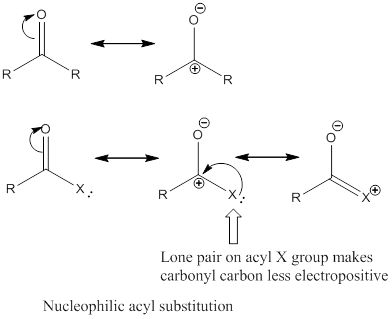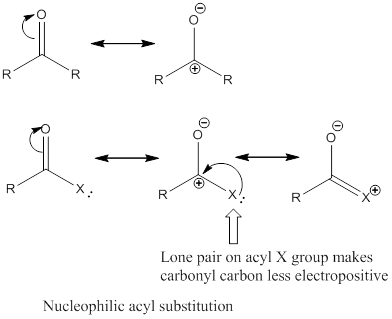
Concept explainers
(a)
Interpretation:
The products for the given reaction should be identified.
Concept Introduction:
Nucleophilic acyl substitution:
The carbonyl group of a

(b)
Interpretation:
The products for the given reaction should be identified.
Concept Introduction:
Reaction for aldehydes and ketones in presence of primary
The carbonyl group of a carboxylic acid or carboxylic acid derivative gets converted into imine in presence of primary amine which is depicted as follows,

(c)
Interpretation:
The products for the given reaction should be identified.
Concept Introduction:
The ketone which is carboxylic acid derivative in presence of

(d)
Interpretation:
The product for the given reaction should be identified.
Concept Introduction:
The carbonyl group of a carboxylic acid or carboxylic acid derivative is attached to a group that can be replaced with another group. Therefore, aldehyde and ketone undergoes nucleophilic acyl substitution reactions.
Generally reduction of aldehyde gives primary alcohol and reduction of ketone gives secondary alcohol.

(e)
Interpretation:
The product for the given reaction should be identified.
Concept Introduction:
Nucleophilic acyl substitution:
The carbonyl group of a carboxylic acid or carboxylic acid derivative is attached to a group that can be replaced with another group. Therefore, aldehyde and ketone undergoes nucleophilic acyl substitution reactions.
Generally reduction of aldehyde gives primary alcohol and reduction of ketone gives secondary alcohol.

(f)
Interpretation:
The product for the given reaction should be identified.
Concept Introduction:
Nucleophilic acyl substitution:
The carbonyl group of a carboxylic acid or carboxylic acid derivative is attached to a group that can be replaced with another group. Therefore, aldehyde and ketone undergoes nucleophilic acyl substitution reactions.

The carboxylic acid derivatives namely aldehyde and ketones generally gets protected from converted to acetals in presence of
(g)
Interpretation:
The product for the given reaction should be identified.
Concept Introduction:
Nucleophilic acyl substitution:
The carbonyl group of a carboxylic acid or carboxylic acid derivative is attached to a group that can be replaced with another group. Therefore, aldehyde and ketone undergoes nucleophilic acyl substitution reactions.

Want to see the full answer?
Check out a sample textbook solution
Chapter 17 Solutions
Organic Chemistry
- pls helparrow_forwardpls helparrow_forward35) Complete the following equation by drawing the line the structure of the products that are formed. Please note that in some cases more than one product is possible. You must draw all possible products to recive full marks! a. ethanol + 2-propanol + H2SO4 → b. OH conc. H2SO4 CH2 H3C CH + K2Cr2O7 C. d. H3C A pressure CH3 + H2 CH Pt catalystarrow_forward
- 21) The rate of reaction depends upon: a. the concentration and nature of reactants b. the temperature of the reaction C. whether or not a catalyst was used d. all of the above 22) A Maxwell-Boltzmann curve shows the distribution of molecular energies in a reaction system. When the temperature in this system is increased, the peak is a. higher and further to the right. b. higher and further to the left. c. lower and further to the right. d. lower and further to the left. 23) Which of the following correctly describes the reaction represented by the reaction below? CaCO3 (s) + energy → CaO (s) + CO2 (g) a. It is exothermic and the potential energy is greater in the reactants than the products. b. c. It is exothermic and the potential energy is greater in the products than the reactants. It is endothermic and the potential energy is greater in the products than the reactants. d. It is endothermic and the potential energy is equal for the products and reactants.arrow_forwardpls helparrow_forward27) Draw the energy level diagram and write the full and shorthand electron configuration for a neutral sulfur atom.arrow_forward
- Indicate whether these compounds are isomers, enantiomers, or tautomers. OCH OCH محمد ممدarrow_forward30) Substance A to E below are listed with several of their properties. The identities of the substances are identified in random order below: Iron, ethane, ethanol, sodium nitrate, graphite First classify each substance as either a polar covalent compound, non-polar covalent compound, ionic compound, metallic solid, or network solid. Write your predictions in the sixth coloumn of the chart, under "type of substance." Then, identify the identity of the substance in the last coloumn. Substance Melting Point Boiling Point Solubility in H₂O Electrical Conductivity Type of Substance Identity of Substance (°C) (°C) as: Solid, Liquids, Solution A -182 -88 Insoluble No/No/- B 1538 2862 Insoluble Yes/Yes/- C 308 380 Soluble Yes/Yes/Yes Ꭰ 3456 Insoluble No/-/- E -114 78 Soluble No/No/Noarrow_forwardpls helparrow_forward
- 28) Explain the process of galvanization. In your description, make sure to explain what metal is usually used for galvanization and why this metal used.arrow_forward29) Complete the following table Molecule H₂O NH3 Lewis Dot Diagram VSEPR Diagram Name of VSEPR Shapearrow_forward12) What is the best name to describe the shape of water molecule? a. Angular b. C. Tetrahedral Octahedral d. Trigonal pyramidal 13) Network solids are distinguished from metallic crystals in that: a. Network solids have charged ions, while metallic crystals do not. b. Network solids are composed of molecules, while metallic crystals only have one type of atom. C. Network solids are composed of non-metals. d. Network solids have much lower boiling points.arrow_forward
 ChemistryChemistryISBN:9781305957404Author:Steven S. Zumdahl, Susan A. Zumdahl, Donald J. DeCostePublisher:Cengage Learning
ChemistryChemistryISBN:9781305957404Author:Steven S. Zumdahl, Susan A. Zumdahl, Donald J. DeCostePublisher:Cengage Learning ChemistryChemistryISBN:9781259911156Author:Raymond Chang Dr., Jason Overby ProfessorPublisher:McGraw-Hill Education
ChemistryChemistryISBN:9781259911156Author:Raymond Chang Dr., Jason Overby ProfessorPublisher:McGraw-Hill Education Principles of Instrumental AnalysisChemistryISBN:9781305577213Author:Douglas A. Skoog, F. James Holler, Stanley R. CrouchPublisher:Cengage Learning
Principles of Instrumental AnalysisChemistryISBN:9781305577213Author:Douglas A. Skoog, F. James Holler, Stanley R. CrouchPublisher:Cengage Learning Organic ChemistryChemistryISBN:9780078021558Author:Janice Gorzynski Smith Dr.Publisher:McGraw-Hill Education
Organic ChemistryChemistryISBN:9780078021558Author:Janice Gorzynski Smith Dr.Publisher:McGraw-Hill Education Chemistry: Principles and ReactionsChemistryISBN:9781305079373Author:William L. Masterton, Cecile N. HurleyPublisher:Cengage Learning
Chemistry: Principles and ReactionsChemistryISBN:9781305079373Author:William L. Masterton, Cecile N. HurleyPublisher:Cengage Learning Elementary Principles of Chemical Processes, Bind...ChemistryISBN:9781118431221Author:Richard M. Felder, Ronald W. Rousseau, Lisa G. BullardPublisher:WILEY
Elementary Principles of Chemical Processes, Bind...ChemistryISBN:9781118431221Author:Richard M. Felder, Ronald W. Rousseau, Lisa G. BullardPublisher:WILEY





